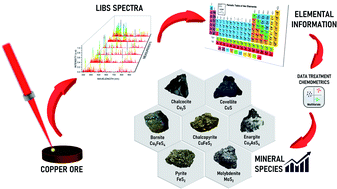Improved mineralogical analysis in copper ores by laser-induced breakdown spectroscopy†
Abstract
Copper and its production process are crucial in the quest to achieve decarbonization of energy sources and electromobility. The quantification of mineral species in copper ores in real-time is important for monitoring and improving the performance of the process. In this work the capability of laser-induced breakdown spectroscopy (LIBS) is expanded for rapid determination of the key mineral species namely bornite (Cu5FeS4), chalcocite (Cu2S), chalcopyrite (CuFeS2), covellite (CuS), enargite (Cu3AsS4), molybdenite (MoS2) pyrite (FeS2), quartz (SiO2), and iron oxides (FexOy) in bulk copper concentrates. Multivariate calibration techniques such as partial least squares regression (PLSR), artificial neural network regression (ANNR) and multivariate curve resolution-alternating least squares (MCR-ALS) were compared as quantification approaches. Moreover, prediction accuracy errors agree with those obtained by standard mineralogical techniques such as SEM-MLA.

- This article is part of the themed collection: JAAS HOT Articles 2022


 Please wait while we load your content...
Please wait while we load your content...